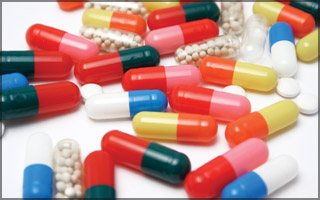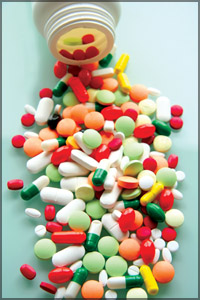The silent epidemic
by K.W.A. JAYAWARDANE
Modern medicines have revolutionalised the way doctors treat
patients, increased life expectancy, and, for many, improved quality of
life. Pharmaceuticals are a multi-billion business, and criminal
elements are trying to cash in with often deadly consequences.
The World Health Organisation (WHO) calls counterfeit, fake and
substandard drugs ‘the silent epidemic’ preying on the sick and denying
patients therapies that can alleviate all suffering and save lives.

This is a problem that affects both developed and developing
countries. It undermines the creditability of health and pharmaceutical
supply system.
Counterfeit legal drugs include falsely-labelled drugs, that were
previously expired, where the active ingredient is fraudulently diluted,
adulterated, substituted, completely misrepresented, or sold with a
false brand name.
A number of counterfeits do not contain any active ingredients, and
instead contain inert substances, which do not provide the patient any
treatment benefits. They also may contain incorrect ingredients,
improper dosages of the correct ingredients, or may contain highly toxic
substances.
Most illegal drugs are produced and sold with the intent to
deceptively represent their origins, authenticity or effectiveness.
Illegal drugs can be easily counterfeited because illegal drug market is
unregulated underground economy that rarely adheres to quality norms or
safety standards.
Majority of counterfeiters carry out their activities in ordinary
households, small cottage industries, or in backyards. The ingredients
they usually use to produce fake medicines are talcum powder, rice
flour, floor polish, cement, boric acid, chalk, rat poison, motor oil
etc.
It is very unfortunate that fake medicines affect the very people who
need real, quality drugs the most: cancer and AIDS patients and those
with heart diseases. Of the 30 medicines the US National Association of
Boards of Pharmacy named in a list of medicines especially susceptible
to counterfeiting, 23 are used in treating HIV/AIDS and cancer.
As a consequence of taking fake, counterfeit or substandard drugs
there will be side effects, drug resistance, allergic reactions,
worsening the condition, therapeutic failure, immunity to the real thing
and death. UN Health and Crime agencies say counterfeit drugs are
killing people and they promote the development of new strains of
viruses, parasites and bacteria.

According to the WHO India is suspected of responsible for about 35
per cent of the world’s production of counterfeit medicines. Another
report says 75 per cent of fake drugs sold world over came from India.
One every four medicines sold there is fake, it says. At lease 11 states
in India do not have laboratories for testing medicines.
In 15 States with functional laboratories, only seven were adequately
equipped and staffed. The problem was so grave that Indian Cabinet once
approved death penalty in an effort to curb the rampant sale and
production of take and counterfeit drugs. The Cabinet decision must be
approved by Parliament to become law.
According to the health authorities in China, 13 per cent of drugs
sold there are fake or substandard. Between 200,000 and 300,000 people
are estimated to die there, each year, because of counterfeit or
substandard medicines.
Chinese government has used execution in the past as a way of showing
it is very serious about trying to get control over the problem.
They executed Zheng Xiaoyu, former chief drug regulator for taking
bribes and gifts worth more than US$ 850,000 when he was the head of the
food and drugs administration. He was found guilty of approving six
types of fake medicines.
In Nigeria and the Ukraine it is estimated that 40 per cent of the
drug supply is counterfeit. In one instance in Nigeria more than 50,000
people were inoculated for meningitis with a fake medicine donated by
another country. The error resulted in 2500 deaths.
One half of all medicines in Pakistan are believed to be fake. In
Russia it is 20 per cent. Studies have shown that many countries in
Africa, parts of Asia and Latin America more than 30 per cent of
medicines sold are fake. In Indonesia it is 25 per cent and Kenya it is
30 per cent.
In the United States it is estimated that 15 per cent of all sold
medicines are fake. The same study estimates that fake medicines
comprise approximately 10 per cent of the global medical market.
The WHO estimates that 200,000 of the one million malaria deaths a
year would be prevented if all the drugs are genuine. It has been found
that between 50 and 90 per cent of malaria drugs sold in Africa are
fake.
The European Alliance for Access to Safe Medicines (EAASM) has
unveiled its comprehensive research report “The Counterfeiting
Superhighway’. It revealed that a frightening 62 per cent of medicines
purchased Online are fake or substandard. These include medicines
indicated to treat serious conditions such as cardiovascular and
respiratory diseases, neurological disorders, and mental health
conditions. 95.6 per cent Online pharmacies researched are operating
illegally. 94 per cent of Websites do not have a named, verifiable
pharmacist.
Over 90 per cent of Websites supply prescription only medicines
without a prescription. 86 per cent Online ‘Pharmacy approved’ stamps
are fake. It reiterates that there is a 3 in 5 chances of receiving a
fake or substandard medicine when you buy Online.
India is our neighbour. It is supplying fake or counterfeit medicines
all over the world. There is no guarantee that they have not reached Sri
Lankan shores. Hence, the authorities have to be vigilant.
The world’s major drug companies have been accused of turning a blind
eye to the multi-billion dollar trade in fake medicines that has
resulted an explosion of child malaria deaths in developing countries.
The pharmacological companies are burying the issue, afraid that any
publicity given to their medicines being fake will lead to a fall in the
sale of the genuine product.
It is believed that evil of the fake drugs is worse than the combined
scourge of malaria, HIV/AIDS, armed robbery and illicit drugs. A US
based centre for medicines predicts that counterfeit drug sales will
reach US$ 75 billion globally in 2010, an increase of more than 90 per
cent from 2005.
Ironically even the experts find it difficult to differentiate
between the two in the naked eye. The drug dealers use modern technology
to supply the same tables and packaging on the fake medicines. They look
the same. The packaging is the same, bottle is the same, texture of the
pill can even be similar.
Tests already exist that can identify counterfeit products, but these
must be carried out in a laboratory by highly trained personnel.
Kingston University researchers have developed a small portable device
that quickly measures the hardness of a tablet matching whether it is
counterfeit.
British researchers have found that laser can be used to detect fake
or counterfeit medicines without opening sealed bottles and packs. The
WHO has created the International Medicinal Products Anti-counterfeiting
Taskforce (IMPACT) comprising all 193 member states to try to coordinate
various efforts around the world.
But with counterfeiters utilizing increasingly sophisticated
technology, many experts believe it will be difficult to stop
counterfeiters from exploiting the ill. Health experts have warned that
the growing menace of potentially lethal or harmful counterfeits, fake,
and substandard medicines has to be contained Otherwise there would be a
global health crisis.
(The writer is the former librarian of the Sri Lanka Medical
Library) |
